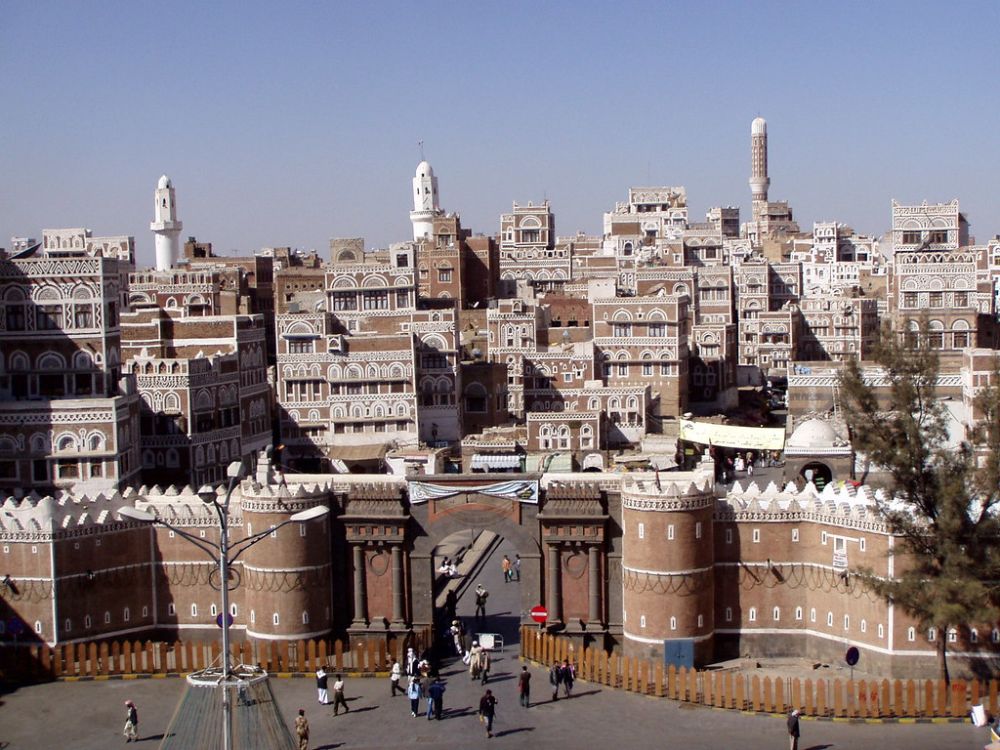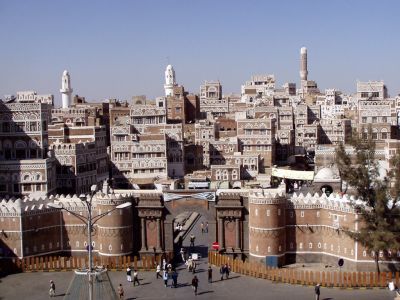

Embark on a journey through time as you walk through the ancient streets of Sana'a's Old City, a UNESCO World Heritage site. The city, said to be founded by Shem, the son of Noah, is one of the oldest continuously inhabited cities in the world. Stroll along the labyrinthine alleyways lined with stunningly decorated buildings that date back to the 11th century, featuring unique Yemeni architecture with their distinctive qamariya windows. Marvel at the towering mud-brick houses and visit bustling souks where you can find a plethora of goods ranging from spices to intricately woven textiles. Take in the sights and sounds of this historic marketplace and see local life unfold in the heart of the city. The tour is an immersive cultural experience that allows you to explore not only the landmarks but also the daily lives of the residents of Bab al Yemen.
Al Saleh Mosque is an architectural marvel and one of the most significant modern mosques in Yemen. Standing as a symbol of unity, the mosque was opened to the public in 2008 and encompasses Islamic architectural elements from across the world. Stretching over 27,300 square meters, it can accommodate over 40,000 worshippers. A visit here is not just about admiring the grandeur of the building; it's also an opportunity to experience first-hand the spiritual life of the local Muslim community. The mosque welcomes non-Muslim visitors outside prayer times, offering a chance to observe the harmony and discipline of Islamic worship. With its beautiful white stone and towering minarets, the mosque is also a perfect place for photography enthusiasts. Take a guided tour to learn about the history, architectural design, and cultural significance of this religious landmark.
Culinary enthusiasts will delight in a traditional Yemeni cooking class that promises an authentic taste of local culture. Learn how to prepare classic Yemeni dishes such as Saltah, a meat-based stew, or Bint al Sahn, a sweet and buttery layered pastry typically drizzled with honey. Your cooking class takes place either in a traditional Yemeni home or a local culinary school, where a seasoned chef will guide you through the intricacies of Yemeni cuisine. Understand the importance of spices like hawaij and the methods of creating the perfect balance of flavors. The hands-on experience not only teaches you about food but also provides insight into Yemeni traditions and daily life. At the end of the session, enjoy the fruits of your labor by sharing a meal with your hosts or classmates.
Experience the unique cultural phenomenon of qat chewing in Yemen with a visit to a local qat market. Qat, a mild stimulant plant that is deeply entrenched in Yemeni society, is chewed by many Yemeni men and women during social gatherings. The markets become lively in the afternoon as people shop for the freshest leaves. Exploring the qat market allows visitors to gain insight into this daily ritual and its socioeconomic implications. Observe the hustle and bustle as customers haggle and inspect the qat bundles, looking for the juiciest stems. While qat is controversial due to its effects on health and the economy, the market is an integral part of Yemeni culture, offering a truly local experience. Note that visitors are not encouraged to participate in chewing qat; this activity is intended as a cultural observation.
Bab al Yemen, the iconic gate leading into the Old City of Sana'a, provides a picturesque background for photography aficionados. Embark on a photography walk that will take you through the heart of Sana'a's history. Capture the essence of Yemeni life as you snap photos of the ancient gate, bustling markets, and old-world architecture. Bab al Yemen is an excellent starting point to meet friendly locals, photograph the unique landscape of the old city, and document the vibrant day-to-day scenes. Whether you're a professional photographer or an enthusiast, the city's rich colors and textures offer countless opportunities to capture stunning visuals. Join a guided tour to learn about the history and significance of the sights you photograph, or wander independently to find your own unique perspective of the city.
Souk al-Milh, located in the heart of Sana'a's Old City, is a historical market that dates back centuries. This bustling market area offers a variety of goods, from spices and grains to handmade crafts and jewelry. As you navigate the maze of stalls, you'll encounter vendors selling traditional Yemeni attire, vibrant fabrics, and intricately-designed silverware. The souk isn't just a place to shop; it's also where you can observe the local community's interactions and haggle alongside residents. The fragrant aroma of spices such as cardamom, cumin, and cloves wafts through the air, providing a feast for the senses. Visiting Souk al-Milh is a cultural adventure that promises a rich tapestry of sights, sounds, and smells. Don't miss out on trying some local street food or grabbing a Yemeni coffee while exploring the market.
The Yemeni House Museum is a cultural gem offering visitors a glimpse into traditional Yemeni life and heritage. Situated in a beautifully restored house within the old city, the museum showcases a vast collection of artifacts, furnishings, and art typical of a well-to-do Yemeni household from the past. As you wander through the rooms, you'll discover ancient manuscripts, intricately carved wooden doors, and ornate stained glass windows. A tour guide can provide valuable context, sharing stories and explanations of the items on display and their significance in Yemeni culture. You'll leave with a deeper appreciation for the country's history and an understanding of the traditional lifestyle that has shaped modern Yemen. The museum also has a quaint shop where you can purchase local crafts as souvenirs of your visit.
A short distance from Sana'a lies Dar al-Hajar, known as the Rock Palace, an iconic symbol of Yemen's rich history. Built atop a towering rock formation, this former royal palace offers breathtaking views of the surrounding valley and villages. The palace, with its multiple floors and rooms built into the rock, reflects the ingenuity of Yemeni architecture. A visit to Dar al-Hajar is an opportunity to explore the historic rooms, chambers, and courtyards, all while learning about its past as a summer retreat for Imam Yahya and his family in the 1930s. Bring a camera to capture the stunning vistas from the palace's terraces. The journey to and from Dar al-Hajar will also allow you to witness the rural landscapes and traditional stone houses of the Yemeni countryside.
A visit to Bab al Yemen is incomplete without experiencing the local café culture. Spend an evening at a traditional Yemeni café sipping on spiced tea and possibly trying the hookah, also known as shisha. The tea, often infused with mint or other herbs, provides a refreshing end to a day of sightseeing. Engaging in this leisure activity is a chance to mingle with locals, watch the world go by, and enjoy the ambient sound of Oud music in the background. The café setting is typically decorated with ornamental carpets and cushions, offering a cozy and authentic atmosphere. While smoking hookah is a popular pastime in the region, it is not for everyone; visitors can still enjoy the atmosphere of the café and opt for just the tea experience.
Wadi Dhahr, a short drive from the capital city of Sana'a, provides a scenic escape for nature enthusiasts and hikers. The valley is renowned for its lush agricultural terraces and traditional Yemeni buildings that cling to the mountainside. Embark on a guided hike through the valley to experience the natural beauty of Yemen's countryside. The trails offer varying difficulty levels, accommodating experienced hikers and casual walkers alike. Along the way, you'll witness farmers tending to their crops, ancient irrigation systems, and perhaps the occasional camel. Wadi Dhahr is not only a haven for hikers but also a living example of Yemen's sustainable agriculture and the harmony between people and nature.
